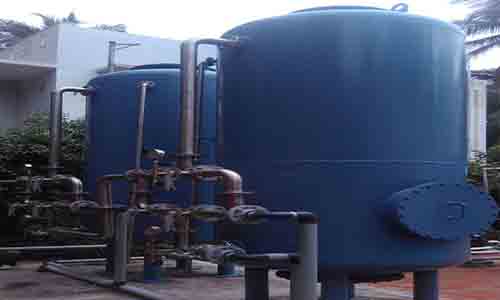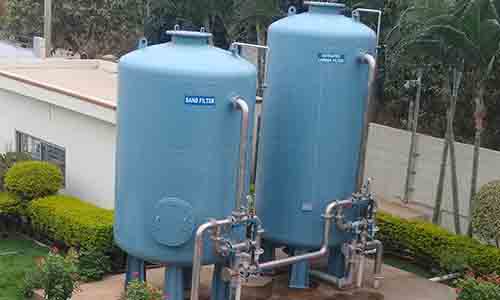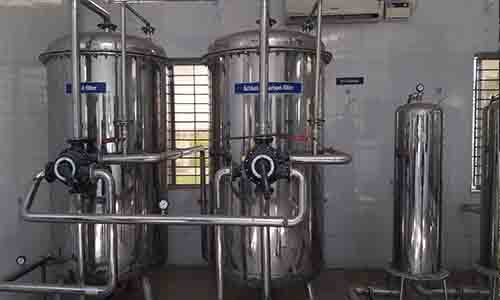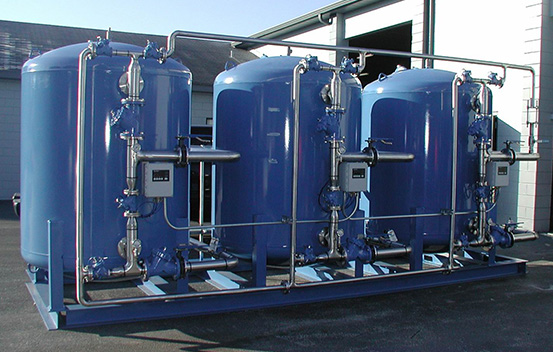DM Plants (Demineralization Plants)
We have offering excellent quality Demineralization Plant manufactured through technically advanced process. Demineralization Water Treatment Plant, provided by our company, is highly demanded in various industries and municipal sectors
Demineralization (or) Deionisation is the process of removing mineral salts from water by using the ion exchange process. With most natural water sources it is possible to use Demineralization and produce water of a higher quality than conventional distillation.
We manufacture a Wide range of Dematerializing plants for industrial process water applications. They are available in different sizes and materials, manually operated, semiautomatic or fully automatic.

Principle of Operation.
A Typical two-bed DM Plant consists of two MS Rubber lined Pressure vessels connected in series along with its internal fittings. The first unit consists of high capacity strongly acidic cation exchange resin, which converts positive ions of salt and replaces them with hydrogen ions to form respective acids, which are absorbed in next vessel by strongly basic anion exchange resin. The water obtained by this process shows conductivity less than 20 µ S / cm at 25 Deg C and total dissolved solids less than 10 ppm
Further high purity water can be achieved by Mixed Bed Demineralization, which are designed to produce high purity treated water. They can be used as polishing units after two bed DM Plant to obtain high purity water. Mixed Bed Demineralization are single column units, filled with strongly acidic cation and strongly basic anion exchange resins mixed together.
There are four distinct stages in the operation of Demineralization- Service
- Backwashing
- Regeneration
- Rinse/remix
Service
In the Service cycle the water enters the vessel and passes through the Resin bed of the respective exchangerBackwashing
After the resins are exhausted, the bed is backwashed. Backwashing is carried out by a uniform upward flow of water through the resin bed. The backwash step expands the resin bed releasing any entrapped particulate matter & removes the channeling in the resin column if occurred during the service cycle.Regeneration
When the ion exchange resins loose all the exchangeable ions, they require regeneration to restore them back to hydrogen or hydroxyl form depending upon whether they are cation or anion resins. To achieve this 4 - 5% concentrated solution of Hydrochloric acid is used for cation resin and a 4% - 5% concentrated solution of caustic soda for anion resin.
Rinse
The final stage of regeneration is to rinse the resins of excess regenerantAdvantages :
- Variety of cost effective standard models.
- Improved aesthetics and rugged design.
- User friendly, low maintenance and easy to install.
- Simpler distribution and collection systems.
- Quick availability.
- Pre dispatch assembly check.
- The multiport valves are top mounted as well as side mounted with the necessary high pressure rating PVC piping.
- Single valve operation as compared to the six valves in conventional filters
- Each operating step is clearly marked on the valve, thereby eliminating chances of error in the operating sequence.
- Single valve assembly, with its simplified frontal Piping, simpler distribution collecting systems is Very easy to install.
- Rust free
- Less power consumption
- Durable
- Economical
- High shelf life
Major Applications :
Boilers feed water, Textiles, Pharmaceuticals, Chemicals, Breweries, Swimming pools, Potable Water, Hospitals, Automobile, and Battery, Fertilizers.- Ion Exchange Plants
- Softener
- Industrial DM Plant
- Two Stage & Multi Stage DM Plants
- Mix Bed Demineraliser
- De-Gasifiers
- Cation Polisher
- Manual/Automatic Plants
- Pharmaceutical Industry
- Power Plant
- Oil & Gas sector
- Chemical Industries
- Textile Industries






